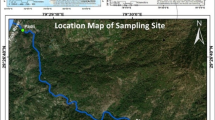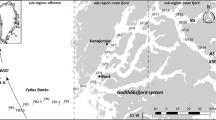Abstract
The functional groups of planktonic protist communities and their responses to the changes of environmental conditions were investigated in a semi-enclosed shrimp-farming pond in Qingdao, Shan-dong Province, China, during a six-month study period (a complete shrimp-culture cycle) from May to October 2002. The results reveal that: (1) the protist communities represented five trophic and functional groups of the species identified, about 60% were photoautotrophs, 20% algivores, 12% bacterivores, 5% raptors and about 3% non-selectives; (2) the photoautotrophs, algivores and bacterivores were the primary contributors to the changes in the protist communities in short temporal scales, the succession of dominance typically being bacterivores→photoautotrophs→algivores, with the raptors dominating the protist communities in a single sample (early June); (3) the photoautotrophs and non-selectives were the primary contributors to the peak of protist abundance in early October whereas the photoautotrophs, bacterivores, raptors and non-selectives mainly gave rise to two bimodal peaks of biomass in July and October respectively; (4) five functional groups of protist communities represented significant correlations with water nutrients (i.e., NH3-N, NO3-N, and PO4), either alone or in combination with temperature, of which algivores and raptors were strongly correlated with phosphate and the concentration of Chl a, while bacterivores were strongly related to nitrogen and the concentration of bacteria. These findings confirm that planktonic protists are potentially useful bioindicators of water quality in the semi-enclosed mariculture system.
Similar content being viewed by others
References
Anderson O R. 1988. Perspectives on Ciliate Ecology. Comparative protozoology, ecology, physiology, life history. New York: Springer-Verlag
Anderson M J, Gorley R N, Clarke K R. 2008. PERMANOVA+ for PRIMER Guide to software and Statistical Methods. Plymouth: PRIMER-E Ltd
Brandini F P. 1993. Phytoplankton biomass in an Antarctic coastal environment during stable water conditions-implications for the iron limitation theory. Mar Ecol Prog Ser, 93: 267–275
Cairns J Jr, Plafkin J L, Kaesler R L, et al. 1983. Early colonization patterns of diatoms and protozoa in fourteen fresh-water lakes. J Protozool, 30: 47–51
Caroppo C. 2000. The contribution of picophytoplankton to community structure in a Mediterranean brackish environment. J Plankton Res, 22: 381–397
Clarke K R, Ainsworth M. 1993. A method of linking multivariate community structure to environmental variables. Mar Ecol Progr Ser, 92: 205–219
Clarke K R, Gorley R N. 2006. PRIMER 6 User Manual/Turorial. Plymouth: PRIMER-E Ltd
Curds C R. 1992. Protozoa in the Water Industry. Cambridge: Cambridge University Press
Cytryn E, Gelfand I, Barak Y, et al. 2003. Diversity of microbial communities correlated to physiochemical parameters in a digestion basin of a zero-discharge mariculture system. Environ Microbiol, 5: 55–63
Fernandez-Leborans G. 2001. Relative importance of protozoan functional groups in three marine sublittoral areas. J Mar Biol Ass UK, 81: 735–750
Fernandez-Leborans G, Fernandez-Fernandez D. 2002. Protist functional groups in a sublittoral estuarine epibenthic area. Estuaries, 25: 382–392
Gifford F J. 1991. The protozoan-metazoan trophic link in pelagic ecosystems. J Protozool, 38: 81–86
Gilabert J. 2001. Seasonal plankton dynamics in a Medierranean hypersaline coastal lagoon: the Mar Menor. J Plankton Res, 23: 207–217
Gong Jun, Song Weibo, Warren A. 2005. Periphytic ciliate colonization: annual cycle and responses to environmental conditions. Aquat Microbial Ecol, 39: 159–179
Grey J, Laybourn-Parry J, Leakey R J G, et al. 1997. Temporal patterns of protozooplankton abundance and their food in Ellis Fjord, Princess Elizabeth Land, Eastern Antarctica. Estuar Coast Shelf Sci, 45: 17–25
Laybourn-Parry J, Rogerson A, Crawford D W. 1992. Temporal patterns of protozooplankton abundance in the Clyde and Loch Striven. Estuar Coast Shelf Sci, 35: 533–543
Leakey R J G, Burkill P H, Sleigh M A. 1993. Planktonic ciliates in Southampton Water: quantitative taxonomic studies. J Mar Biol Ass UK, 73: 579–594
Madoni P, Braghiroli S. 2007. Changes in the ciliate assemblage along a fluvial system related to physical, chemical and geomorphological characteristics. Europ J Protistol, 43: 67–75
Mura M P, Satta M P, Agusti S. 1995. Water-mass influence on summer Antarctic phytoplankton biomass and community structure. Polar Biol, 15: 15–20
Nuccio C, Melillo C, Massi L, et al. 2003. Phytoplankton abundance, community structure and diversity in the eutrophicated Orbetello lagoon (Tuscany) from 1995 to 2001. Oceanol Acta, 26: 15–25
Patterson D J, Larsen J, Corliss J O. 1989. The ecology of heterotrophic flagellates and ciliate living in marine sediments. Prog Protistol, 3: 185–277
Peštová D, Macek M, Pérez M E M. 2008. Ciliates and their picophytoplankton-feeding activity in a high-altitude warm-monomictic saline lake. Europ J Protistol, 44: 13–25
Polat S, Koray T. 2007. Planktonic dinoflagellates of the northern Levantine Basin, northstern Mediterranean Sea. Europ J Protistol, 43: 193–204
Pratt J, Cairns J Jr. 1985. Functional groups in the Protozoa: roles in differing ecosystems. J Protozool, 32: 415–423
Song Weibo, Zhao Yuanjun, Xu Kuidong, et al. 2003. Pathogenic Protozoa in Mariculture (in Chinese). Beijing: Science Press
Steidinger K, Tangen K. 1997. The planktonic marine flagellates. In: Tomas C R, ed. Identifying Marine Phytoplankton. San Diego: Academic Press
Xu Henglong, Song Weibo, Warren A, et al. 2008. Planktonic protist communities in a semi-enclosed mariculture pond: structural variation and correlation with environmental conditions. J Mar Biol Ass UK, 88: 1353–1362
Author information
Authors and Affiliations
Corresponding author
Additional information
Foundation item: The National Natural Science Foundation of China under contract Nos 40676076 and 30700069; the Darwin Initiative Programme under contract No. 14-015; a grant from the Center of Excellence in Biodiversity Research, King Saud University.
Rights and permissions
About this article
Cite this article
Xu, H., Warren, A., Al-Rasheid, K.A.S. et al. Planktonic protist communities in semi-enclosed mariculture waters: temporal dynamics of functional groups and their responses to environmental conditions. Acta Oceanol. Sin. 29, 106–115 (2010). https://doi.org/10.1007/s13131-010-0055-6
Received:
Accepted:
Published:
Issue Date:
DOI: https://doi.org/10.1007/s13131-010-0055-6




